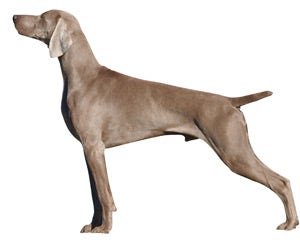Weimaraner
-
Overview
Weimaraners are energetic, elegant dogs whose sleek, shimmering coats reflect their graceful movements. They need plenty of activity and will not stand for being left out of family activities or spending time away from their owners.
For those who want to spend lots of time in the company of an intelligent, opinionated and loving companion, the Weimaraner makes an amusing pet who will fit right in with an active lifestyle.
-
Personality
-
Coat Care

Weekly brushing with a soft bristle brush will keep hair tidy and help the Weimaraner's skin stay healthy. It will also decrease the amount that the Weimaraner sheds.
With preparation, perseverance and a positive attitude, bathing can become a fun and fulfilling part of the regular grooming cycle, while helping your dog avoid many diseases and infections.
Smooth coated breeds adhere to the general rule of dog bathing: about once every three months. The coat should end up fresh smelling, shiny, with no loose or shedding hair. First give the dog a good brushing to remove dead hair and mats. Place a rubber mat in the tub to provide secure footing and fill the tub with three to four inches of lukewarm water. Use a spray hose, pitcher or unbreakable cup to wet the dog, taking caution to avoid getting water in the eyes, ears and nose. Massage in pet shampoo, saving the head for last. Immediately rinse thoroughly, starting with the head to prevent soap from dripping into the eyes. Towel dry. Wipe wrinkled breeds with a soft cloth and make sure they are totally dry after bathing.
Clipping or trimming your dog’s coat is far easier than you would ever imagine. With the right clipper, trimmer and scissors, giving your dog a haircut is easy on your wallet and your schedule.
Dogs with smooth coats generally only require trims and tidying up in areas of excessive hair growth using a trimmer or blunt scissors. It's always wise to take a dog for a short walk or exercise to calm them down before trimming. Remember to brush the coat first to remove any tangles and mats. Don't forget to trim around the paws, pads, tail, chest and sanitary areas, as needed. The coat should lay flat and smooth against the body when finished.
Many dog owners are apprehensive about trimming their dog’s nails because they are nervous about cutting into the quick. But with the right conditioning and careful cutting, nail clipping can be a simple, stress-free activity for you and your dog.
Provide your dog with plenty of positive reinforcement and even treats to help associate nail clipping with a positive experience. As you start to clip, gently press on your dog’s paws to help him become accustomed to the feeling of having his nails clipped. Then, work gradually, shaving down just a thin portion of the nail at first to make sure you don’t reach the quick. Clip one nail, reward your dog with a treat, and stop to give him some positive reinforcement before moving on. Gradually increase the number of nails you clip in one sitting to help your dog get used to the process. Never trim extremely long nails down to a short nail in one sitting, because this is an excellent way to accidently quick the dog’s nail. Instead, work gradually, shaving small portions of your dog’s nails off each time.
You can tell if you’re getting close to the quick by the texture of your dog’s nail. The nail is hard closer to the surface and becomes softer as you get closer to the quick. If your dog’s nail starts to feel softer, that’s a good indication that you’re getting close to the quick.
Weimaraners' soft, silky ears can be sensitive and are prone to infection. Make sure to clean their ears and wash them out if your Weimaraner romps about in the mud.
Many owners do not realize how important it is to brush your pet’s teeth on a regular basis. Some dogs are prone to dental problems and sensitive teeth, especially small dogs with tiny teeth and dogs with special diets. These problems can be easily combatted with frequent brushing.
Cavities are rare with dogs but gum disease caused by tartar buildup is not, which is why they require regular brushing with toothpaste and a toothbrush formulated specifically for dogs. While daily brushing is ideal, doing so on a weekly basis will be a big help in avoiding the need to bring your dog to a veterinarian for a cleaning, which usually has to be done under sedation.

 India (English)
India (English)
 Middle East and Africa (English)
Middle East and Africa (English)
 South Africa (English)
South Africa (English)
 Australia (English)
Australia (English)
 Japan (日本語)
Japan (日本語)
 South East Asia (English)
South East Asia (English)
 Singapore (English)
Singapore (English)
 Europe (English)
Europe (English)
 United Kingdom (English)
United Kingdom (English)
 Argentina (Español)
Argentina (Español)
 Brazil (Portuguese)
Brazil (Portuguese)
 Colombia (Español)
Colombia (Español)
 Latin America (Español)
Latin America (Español)
 México (Español)
México (Español)
 Chile (Español)
Chile (Español)
 Peru (Español)
Peru (Español)
 Canada (English)
Canada (English)

